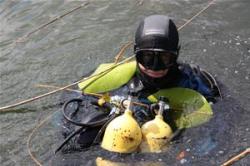INSTITUT SUPERIEUR D'ANTHROPOLOGIE
INSTITUTE OF ANTHROPOLOGY
ONLINE COURSES / COURS A DISTANCE
WINTER TERM : JANUARY 2015
REGISTER NOW
POLOGNE –  Gil Wielki- The first Stone Age settlement identified in Polish waters has been discovered in the lake Gil Wielki, Iława Lake District (Warmia and Mazury)."In shallow water in the reservoir we found a large amount of animal bones, remains of tools made of antler and numerous fragments of pottery, used at various times by ancient communities. Among them, the fragments that caught our attention relate to the tradition of late Neolithic, probably associated with the so-called Corded Ware culture" - told PAP Dr. Andrzej Pydyn. Researchers are now waiting for the results of physical and chemical analyzes, which should ultimately confirm the suggested, the early timeline of the flooded village. According to Dr. Pydyn, examples of other countries show that the sites of this type have very high research potential that allows you to recreate not only the material culture, but also the environment of prehistoric communities. The researcher noted that science does not know many Corded Ware culture settlements, which further increases the importance of the discovery. It is not only this year find of archaeologists from Toruń in Iława Lake District. The result of this work include finding several new potential archaeological sites in lakes Iławskie, Drwęckie and Grażymowskie.
Gil Wielki- The first Stone Age settlement identified in Polish waters has been discovered in the lake Gil Wielki, Iława Lake District (Warmia and Mazury)."In shallow water in the reservoir we found a large amount of animal bones, remains of tools made of antler and numerous fragments of pottery, used at various times by ancient communities. Among them, the fragments that caught our attention relate to the tradition of late Neolithic, probably associated with the so-called Corded Ware culture" - told PAP Dr. Andrzej Pydyn. Researchers are now waiting for the results of physical and chemical analyzes, which should ultimately confirm the suggested, the early timeline of the flooded village. According to Dr. Pydyn, examples of other countries show that the sites of this type have very high research potential that allows you to recreate not only the material culture, but also the environment of prehistoric communities. The researcher noted that science does not know many Corded Ware culture settlements, which further increases the importance of the discovery. It is not only this year find of archaeologists from Toruń in Iława Lake District. The result of this work include finding several new potential archaeological sites in lakes Iławskie, Drwęckie and Grażymowskie.
http://www.naukawpolsce.pap.pl/en/news/news,402280,archaeologists-have-discovered-a-sunken-village-from-millennia-ago.html
RUSSIE –  Kislovodsk - Russian archaeologists have discovered ancient cave paintings dating back to 3000 BC in a gorge in southern Russia, they said. "A few days ago we found five drawings, fairly large fragments, on the territory of the Khasaut gorge," archaeologist Andrei Belinsky was quoted as saying Tuesday by the Interfax news agency. "This is a great discovery because no one has ever seen them before," said Belinsky, who heads the Stavropolsky region's Heritage cultural museum. Belinsky added that the paintings, which were discovered near the Caucasian town of Kislovodsk, were made using ochre paint and had been dated back to the Third Bronze Age. One of the paintings discovered in the gorge features a hunting scene as well as figures that appear to be from another world — leading scholars to conclude the paintings may have been used in ancient rituals, Interfax reported. Ochre, which comprises natural earth pigments, is revered for its long-lasting qualities and many cave paintings discovered around the world were made using the mineral-based paint.
Kislovodsk - Russian archaeologists have discovered ancient cave paintings dating back to 3000 BC in a gorge in southern Russia, they said. "A few days ago we found five drawings, fairly large fragments, on the territory of the Khasaut gorge," archaeologist Andrei Belinsky was quoted as saying Tuesday by the Interfax news agency. "This is a great discovery because no one has ever seen them before," said Belinsky, who heads the Stavropolsky region's Heritage cultural museum. Belinsky added that the paintings, which were discovered near the Caucasian town of Kislovodsk, were made using ochre paint and had been dated back to the Third Bronze Age. One of the paintings discovered in the gorge features a hunting scene as well as figures that appear to be from another world — leading scholars to conclude the paintings may have been used in ancient rituals, Interfax reported. Ochre, which comprises natural earth pigments, is revered for its long-lasting qualities and many cave paintings discovered around the world were made using the mineral-based paint.
http://www.themoscowtimes.com/news/article/russian-archaeologists-discover-cave-paintings-dated-3000-bc/509428.html
FRANCE –  Grozon - On savait que les fouilles préventives permettaient quelquefois des découvertes majeures. À Grozon, dans le Jura, sur le terrain d'un futur pavillon, des archéologues dont mis au jour des vestiges uniques en France. Une saline datant du VIIème siècle ...600 m² de fouilles ... qui ont permis de mettre au jour les vestiges d'une exploitation de sel datant du VIIème siècle. Une découverte majeure quand on sait que les salines antérieures au XIVème siècle sont rares et peu connues . Protégées par l'eau de la nappe phréatique pendant des siècles, les socles de construction en bois sont bien visibles. On voit même sur certaines parties de la structure des traces qui pourraient indiquer la présence de portes ou encore la marque d'outils. Par ailleurs, une construction en pierre a également été découverte alors que les spécialistes ont toujours pensé que tout était fait en bois à l'époque.
Grozon - On savait que les fouilles préventives permettaient quelquefois des découvertes majeures. À Grozon, dans le Jura, sur le terrain d'un futur pavillon, des archéologues dont mis au jour des vestiges uniques en France. Une saline datant du VIIème siècle ...600 m² de fouilles ... qui ont permis de mettre au jour les vestiges d'une exploitation de sel datant du VIIème siècle. Une découverte majeure quand on sait que les salines antérieures au XIVème siècle sont rares et peu connues . Protégées par l'eau de la nappe phréatique pendant des siècles, les socles de construction en bois sont bien visibles. On voit même sur certaines parties de la structure des traces qui pourraient indiquer la présence de portes ou encore la marque d'outils. Par ailleurs, une construction en pierre a également été découverte alors que les spécialistes ont toujours pensé que tout était fait en bois à l'époque.
VIDEO = http://france3-regions.francetvinfo.fr/franche-comte/2014/10/16/une-saline-du-haut-moyen-age-decouverte-sur-un-chantier-dans-le-jura-572964.html
BULGARIE –  Ahtopol - During excavations in the medieval fortress Agatopolis in Bulgaria's Black Sea town of Ahtopol, archaeologists have discovered a gate resembling those in Preslav, Pliska and Drustur. Archaeological excavations are taking place in the courtyard of the so-called Former Greek school in Ahtopol. A section of a castle wall with a length of 32 meters, two external and two internal towers and the entrance of one of the gates of the ancient city were found on an area of 330 square meters. According to the head of the archaeological study, Dr. Andrei Aladzhov from the National Archaeological Institute and Museum at Bulgaria's Academy of Science, the closest analogies to the gate in Ahtopol are found in the early medieval Bulgarian cities Pliska, Preslav and Drustur. In his words, it is a testament to Ahtopol's significance among the rulers of the First Bulgarian Empire. During the excavations were found coins and ceramics as well, Bulgarian Telegraph Agency reports. The findings will be added to the collection of the Historical Museum in Tsarevo.
Ahtopol - During excavations in the medieval fortress Agatopolis in Bulgaria's Black Sea town of Ahtopol, archaeologists have discovered a gate resembling those in Preslav, Pliska and Drustur. Archaeological excavations are taking place in the courtyard of the so-called Former Greek school in Ahtopol. A section of a castle wall with a length of 32 meters, two external and two internal towers and the entrance of one of the gates of the ancient city were found on an area of 330 square meters. According to the head of the archaeological study, Dr. Andrei Aladzhov from the National Archaeological Institute and Museum at Bulgaria's Academy of Science, the closest analogies to the gate in Ahtopol are found in the early medieval Bulgarian cities Pliska, Preslav and Drustur. In his words, it is a testament to Ahtopol's significance among the rulers of the First Bulgarian Empire. During the excavations were found coins and ceramics as well, Bulgarian Telegraph Agency reports. The findings will be added to the collection of the Historical Museum in Tsarevo.
http://www.novinite.com/articles/164173/Archaeologists+Find+Medieval+Gate+in+Agatopolis+Fortress+in+Bulgaria%27s+Ahtopol